In the quest to fill every aspect of your home with succulents, you're going to eventually run out of window space. That's when the fat plants will begin to invade interior rooms that aren't blessed with the sun's light.

We’ve done the hard work for you and put together a list of some of the best succulents for indoors that don't need sun. But first, let’s talk about low light succulents and what it takes for them to thrive.
Jump to:
- How much light does an indoor succulent need?
- Do succulents do well in low light?
- Which succulents are best for indoors?
- What indoor plants do well in low light?
- 21 Indoor Succulents That Don't Need Sunlight
- 1. Snake Plant, Sansevieria trifasciata
- 2. Jade Plant, Crassula ovata
- 3. Bear Paws, Cotyledon Tomentosa
- 4. Zebra Cactus, Haworthia attenuata
- 5. Holiday Cacti, Schlumbergera
- 6. Burro's Tail, Sedum morganianum
- 7. Aloe, Aloe vera
- 8. Ponytail Palm, Beaucarnea recurvata
- 9. Cylindrical Snake Plant, Sansevieria cylindrica
- 10. Gollum Jade, Crassula ovata 'Gollum' aka "Ogre Ears Succulent"
- 11. Panda Plant, Kalanchoe tomentosa
- 12. String of Bananas, Senecio radicans
- 13. Mistletoe Cactus, Rhipsalis baccifera
- 14. Happy Bean, Peperomia ferreyrae
- 15. Little Warty, Gasteria
- 16. Green Ice, x Gasteraloe
- 17. ZZ Plant, Zamioculcas zamiifolia
- 18. String of Pearls, Senecio rowleyanus
- 19. Windowpane Plant, Haworthia turgida
- 20. Devil’s Backbone, Euphorbia tithymaloides
- 21. Flaming Katy, Kalanchoe blossfeldiana
How much light does an indoor succulent need?
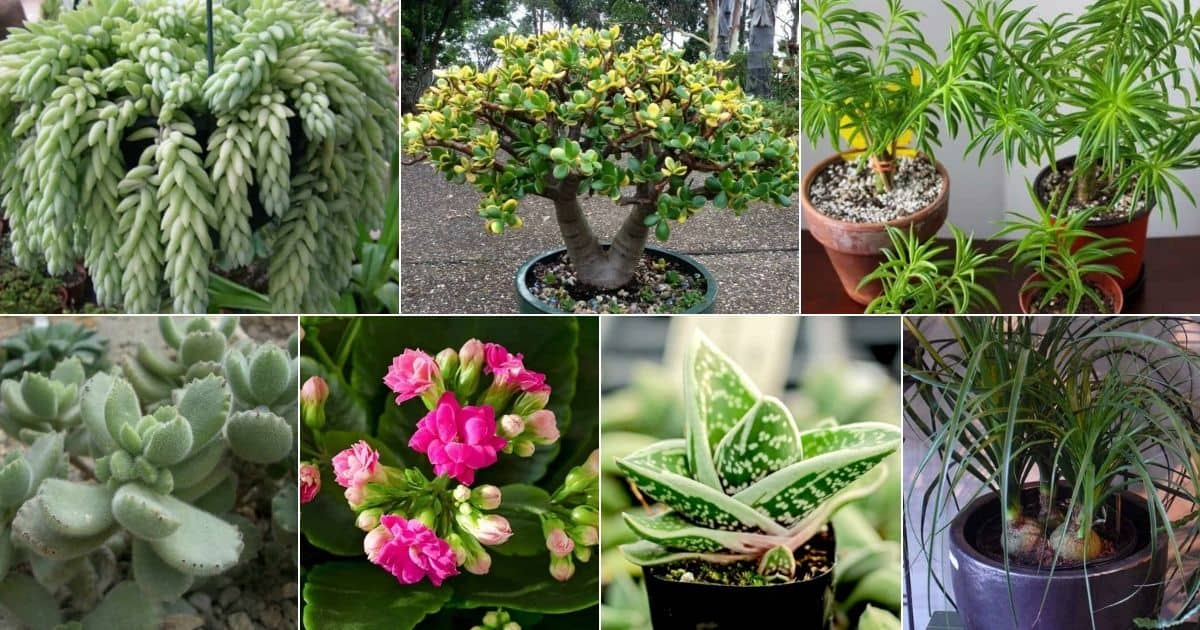
The exact amount of light needed by any indoor plant will vary according to species. Some species of succulents, especially cactus, will do well in direct sunlight, while others may be sunburned by the same light conditions.
Whenever you bring home a new plant, it’s always a good idea to do your research to see if that species of succulent prefers direct sunlight or bright indirect light instead.
If you need help determining how much light is right for your plant, read more on that here.
Do succulents do well in low light?
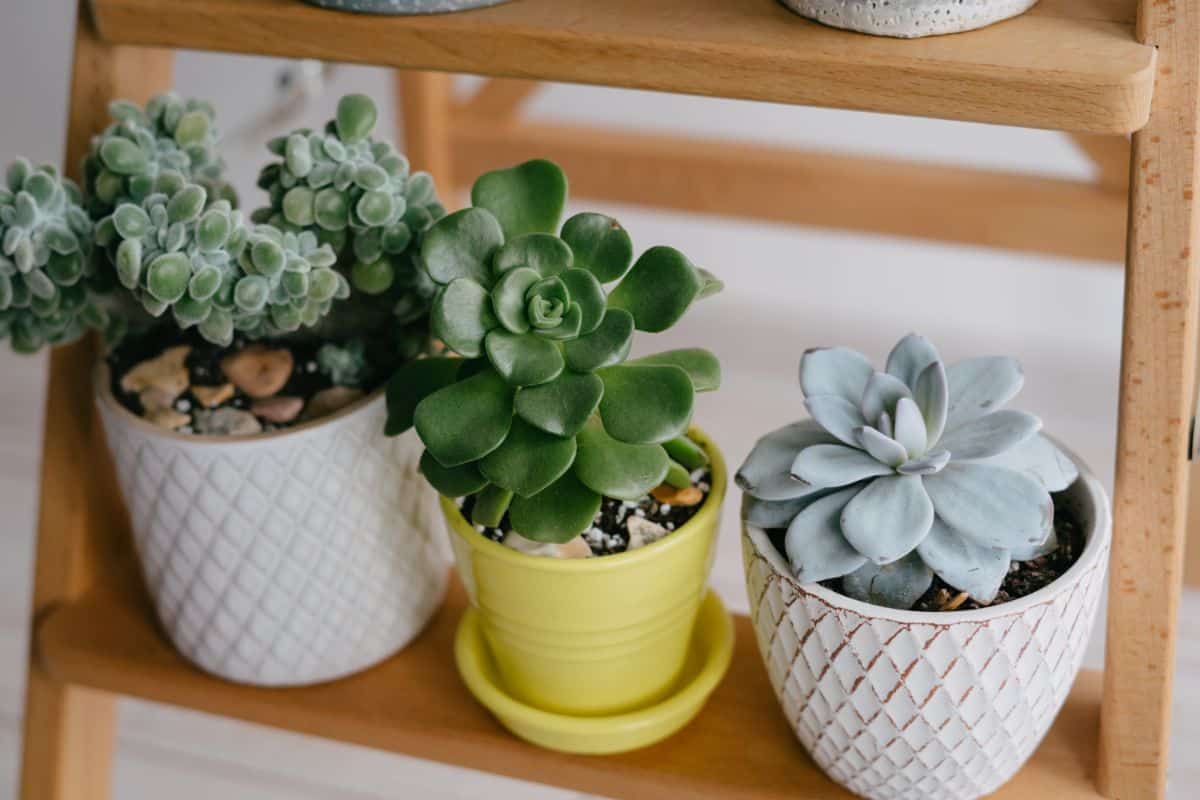
No succulent will survive with a complete lack of light.
However, this varies by species. Some succulents, such as the ones on this list will grow well in low light environments while others may need more light in order to thrive.
It’s important to be aware that if your plants aren’t getting enough light, they may etiolate, or stretch out. Etiolation occurs when plants try to reach areas with more light.
Etiolation doesn’t hurt your plants; it just looks a little funny. If your plant becomes etiolated and you don’t like its new stretched-out appearance, you can always behead it and propagate the top in hopes of growing a succulent that looks more like it should.
Which succulents are best for indoors?
In general, most species of succulents will grow well indoors provided that they receive an adequate amount of light. However, it’s possible that some species may not reach the same size as they would if they were planted outdoors.
One of the benefits of growing succulents indoors is that you can grow a wide variety of different plants no matter what type of climate you live in.
In most cases, your indoor space will be far more consistent in terms of temperature and watering schedule than a succulent would experience outdoors anyway.
This is particularly beneficial with the more difficult to grow species as you have more control over your plants’ conditions than you would if they were planted outdoors.
What indoor plants do well in low light?
If you don't want to get a grow light and provide an oasis for your chunky friends, you've still got options! Here are a bunch of low light succulents that are easiest to grow indoors.
21 Indoor Succulents That Don't Need Sunlight
They'll all do fine with whatever overhead lights or the ambient sun get into the room.
See Related Reading: Ruby Plants Nursery - Interview
1. Snake Plant, Sansevieria trifasciata
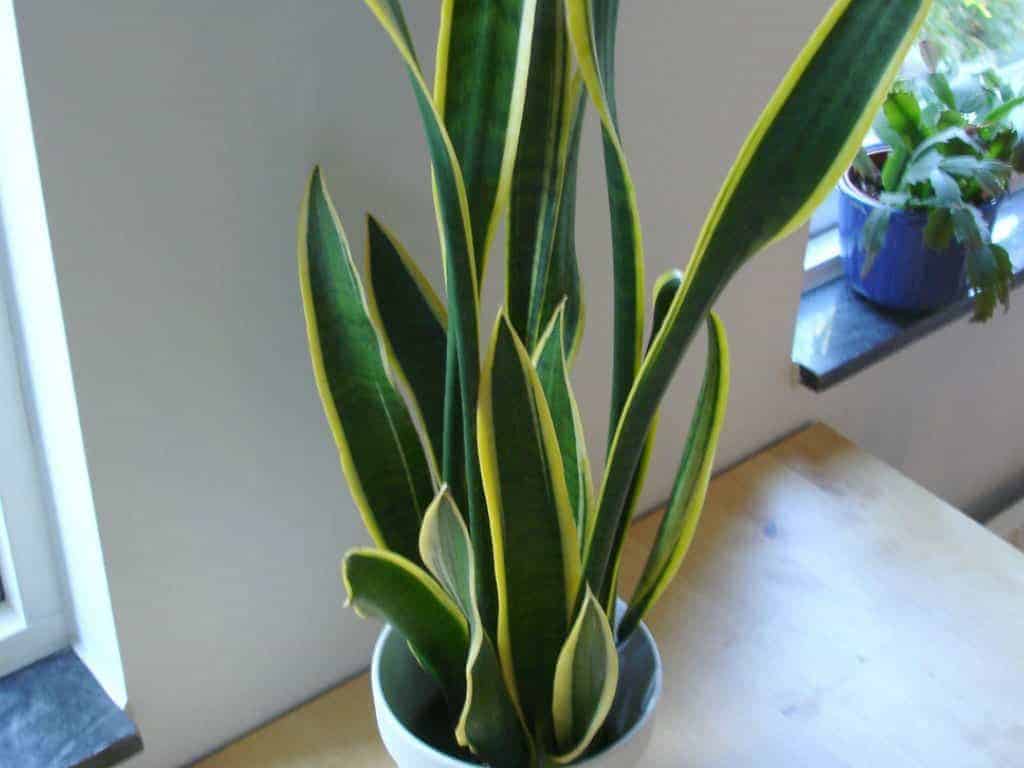
Buy it from:
Also called mother-in-law's tongue, this is the ultimate indoor plant. I have actually found one of these in a closet before, still clinging to life. It had been in there for at least a few weeks. (But seriously, who puts plants in a closet?)
See Also: Jade Plant Care
You'll find snake plants in offices around the globe. They are ubiquitous because they are almost impossible to kill; they actually seem to thrive on neglect.
Water them a few times a month and forget about 'em. They'll survive on whatever light happens to show up.
It's so common, you probably don't have to buy it. Doubtless, you can steal a little shoot (they self propagate often) from your office or the doctor's waiting room or whatever.
See Also: Planet Desert Online Succulent and Cactus Store Review
2. Jade Plant, Crassula ovata
Buy it from:
Another dead-easy plant to keep indoors is the jade plant. Like the snake plant, it's really common everywhere - both indoors and out.
They get really big too; you might not even notice a bush is actually a huge jade plant until you get close enough to touch it. At maturity, they can measure up to 10 feet tall.
The reason they can get so big is that they're so dang resilient. They can bounce back from just about anything, thanks in part to their woody stems.
Most succulents aren't woody, and they lack the ability to recover from prolonged periods of neglect or abuse.
Jade plants can even come back from losing all their leaves (if those leaves don't make new babies by themselves!).
If you don't have one, you can probably get a cutting from a neighbor.
Read more: Jade Plant Care Guide
Read Also: 10 Interesting Facts About Succulents
3. Bear Paws, Cotyledon Tomentosa
Buy it from:
Read Also: Succulent Gardens Online Succulent Nursery Review
A somewhat unconventional entry, but this Cotyledon actually fits really well on a list of indoor succulents. It would still prefer direct light, but because of its unusual growth pattern, you won't notice the etiolation that accompanies low-light situations.
And bear paws are a fun succulent, not to mention a good conversation piece! How often do you see a furry plant? Especially one that won't hurt you when you pet it?
4. Zebra Cactus, Haworthia attenuata
Buy it from:
This is a staple of any cubicle (or succulent arrangement). Native to South Africa, the zebra cactus has a unique aesthetic that works solo or in a group.
The elegant, striking curves are a great complement for one of those cool, geometric 3D printed pots (like those made by our friends at Print A Pot).
No products found.
This Haworthia is slow-growing and easy, which makes it a great fit for an office or desk. Infrequent watering, whatever light is around, and a few whispered compliments are all this plant needs to thrive.
These are pretty common in home improvement stores and the like, but you can get them shipped to you easily.
5. Holiday Cacti, Schlumbergera
Buy it from:
Christmas, Thanksgiving, Easter... whatever kind you have, these are all cared for in mostly the same way. Most people that have a holiday cactus water it a little more frequently than you would normally water a succulent.
These guys thrive, though, it's unclear whether that's because they're particularly hardy or they actually want more water.
I'm not sure why, but every grandparent I've ever met has one of these. Maybe it's given to you when you get grandkids? Not sure, I'm not there yet.
Anyway, you shouldn't have to pay for one. Just ask your grandma for a cutting.
6. Burro's Tail, Sedum morganianum
Buy it from:
Burro's Tail is an awesome succulent because it fits in so many places. It's probably the easiest trailing succulent to grow, which is what gives it so much adaptability.
This Sedum is good in low-light environments too because etiolation is pretty impossible to detect in a vine.
One thing to note is that the leaves on this plant are quite prone to falling off. Don't put it in a high-traffic area or you might find it looking bare. It works great in a corner somewhere, hanging from the ceiling.
These are pretty easy to propagate, so if you find a friend with one, just snag a couple of leaves that fell and throw 'em on some dirt.
7. Aloe, Aloe vera
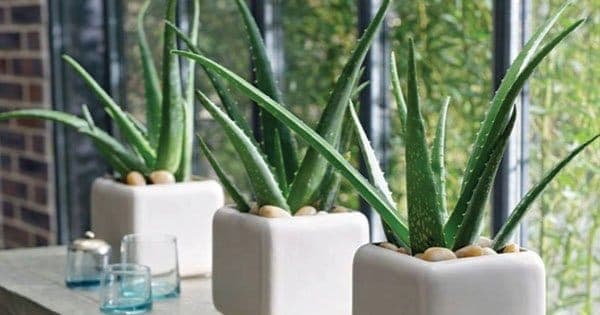
Buy it from:
I probably didn't even need to put this here. If you're looking for indoor succulents, or succulents of any kind really, you've already got an aloe. Even non-plant people have aloes. It's probably the most popular plant in the world.
And you can guess why, it's so darn simple. You definitely don't need a green thumb to grow aloe. Heck, you don't even need thumbs. Just water it once a week and you're good. It'll survive on any windowsill and under any office light.
I can't imagine that you'd ever need to buy this. I think they kind of spontaneously generate in kitchen windows.
Read also: Aloe Vera Succulent Types
8. Ponytail Palm, Beaucarnea recurvata

Buy it from:
This entry might have surprised you, but rest assured, this palm is a succulent. After all, succulents are not a specific family - it's just a catch-all term for plants that store water.
And store water they do! The Ponytail Palm has a cute, little chubby waist. It's another slow-growing, low-maintenance plant.
If you're looking for that leafy aesthetic in an indoor space, which is admittedly hard to get with succulents, this is the plant for you.
You probably won't find it at your local succulent nursery, but it's easy to get online.
9. Cylindrical Snake Plant, Sansevieria cylindrica

Buy it from:
A personal favorite, the cylindrical snake plant looks unique and striking in every situation. It really shines, however, in those cute specialty planters. For example, it makes great spines for a dinosaur or hedgehog.
Read Also: 9 Best Trailing Succulents and Cacti
This is a flexible plant, too! While it would be perfectly happy in direct sunlight, it doesn't mind low-light situations either. Besides, how do you notice if something is etiolated when all it does is grow straight out anyway?
The only advice I would give is to be careful keeping it around eye-level. Each leaf is pretty much a spear - they end in a hard, sharp spike. I nearly put my eye out walking past it one time!
These sometimes show up in bog box stores, but it's a lot easier to find them online
10. Gollum Jade, Crassula ovata 'Gollum' aka "Ogre Ears Succulent"

Buy it from:
The Gollum Jade personifies everything that we like about succulents: plump, easy-to-grow, and weird looking.
It's sometimes called ogre ears because young leaves tend to look a lot like the ears of our favorite ogre - Shrek.
This one is pretty easy to find and care for. You should note, though, that they generally like a little bit more water than other succulents.
For this reason, they don't always fit into arrangements with others. Don't let that stop you though, these look great solo. It's frequently used to make amazing bonsai as well!
These are common in stores that sell plants because they're very hardy.
11. Panda Plant, Kalanchoe tomentosa
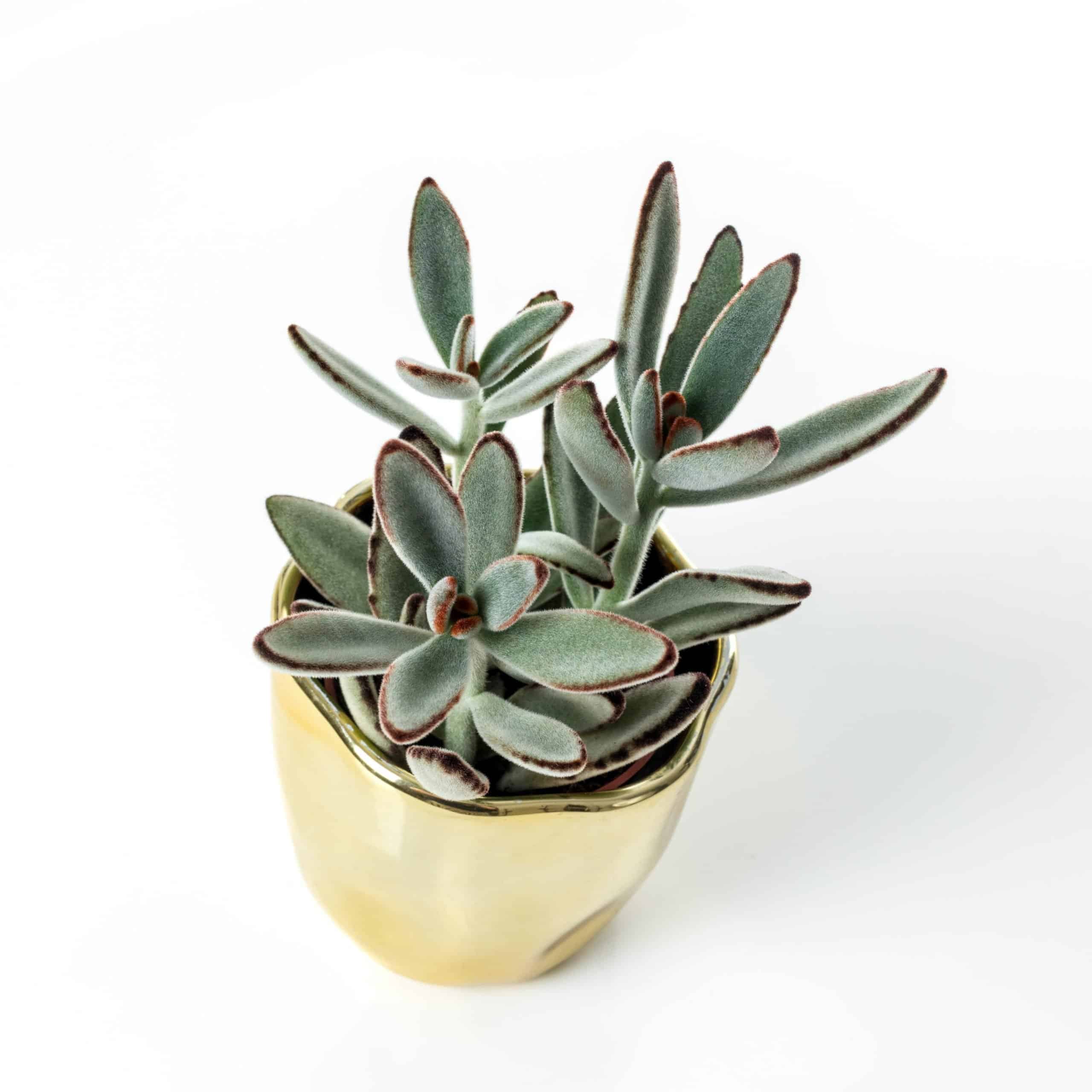
Buy it from:
These fuzzy succulents go by the names Panda Plant, Donkey Ears, and Pussy Ears. Those names may sound strange for a plant, but once you see the Panda Plant, everything makes sense.
The green leaves are covered in a velvety layer of fuzz, giving the leaves a silvery appearance. The leaves also have brown or rust-colored spots along the edges. The spots start out lighter in color and darken with age.
Panda Plants are low maintenance and although they will do best in bright, indirect light, they are perfectly capable of growing in low light environments.
Read Related Topic: Crassula Tetragona
12. String of Bananas, Senecio radicans

Buy it from:
If you’re looking for a hanging or trailing houseplant that will tolerate low light, look no further than the String of Bananas. This unique succulent gets its name from the vibrant green banana-shaped leaves lining its stem.
String of Bananas bloom in late fall or early winter, so expect to be blessed with cinnamon-scented clusters of little white flowers.
Like many other succulents, String of Bananas prefers bright indirect light but will be fine in low light areas. If planted outside, you’ll need to make sure your precious plant receives only filtered or partial sunlight or it may be sunburned.
13. Mistletoe Cactus, Rhipsalis baccifera

Buy it from:
The Mistletoe Cactus is unique from many other species of succulents because it’s an epiphyte. Epiphytic plants grow on the surface of other plants, such as trees, rather than in the ground.
They’re not to be confused with parasitic plants, however, as they do not derive any nutrients from the trees they grow on. They use the debris gathered in the trees’ crevices to grow instead of soil, but they aren’t actually connected to the tree in any detrimental way.
Mistletoe Cacti are great for low light environments because they naturally grow in full or partial shade.
You May Also Like: Dinteranthus
14. Happy Bean, Peperomia ferreyrae

Buy it from:
Also known as Pincushion Peperomia, Happy Bean is a rather petite succulent that is native to Peru. Its slender bean-shaped leaves are lime green in color.
Happy Bean is a popular choice for succulent lovers with limited light as this plant can tolerate conditions ranging from low indoor light to filtered or partial sun outdoors.
This adorable succulent is also perfect for gardeners with limited space as it reaches a maximum height of about six to eight inches.
If you weren’t already convinced that you need a Happy Bean in your succulent collection, they are also non-toxic to pets.
15. Little Warty, Gasteria
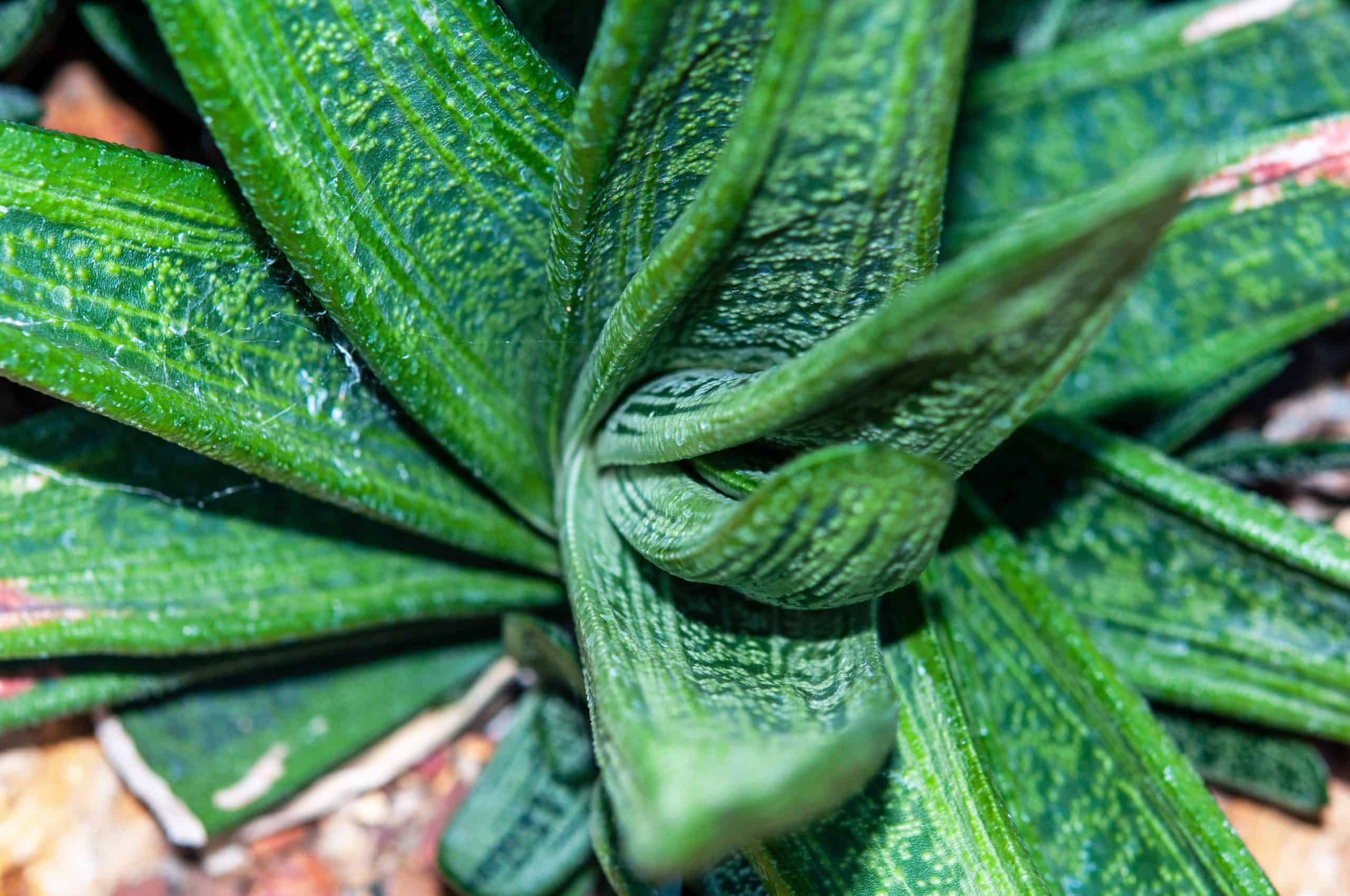
Buy it from:
Gasteria, such as Little Warty, are ideal succulents for gardeners of any experience level. Not only do they tolerate low light conditions, but they also pet safe and low maintenance.
Little Warty is recognizable by the speckled tongue-shaped leaves. In low light conditions, the leaves will be a brighter shade of green while the full sun will produce dark green leaves. The leaves are also covered in small white bumps or tubercles.
When in bloom, Little Warty produces a tall stalk with vibrant coral flowers. With time, this plant will produce offsets and grow in a clumping or mounding formation.
16. Green Ice, x Gasteraloe

Buy it from:
If you’re interested in adding a hybrid to your collection of succulents, consider bringing home a Gasteraloe. As the name implies, Green Ice is a hybrid between Aloe and Gasteria.
The leaves of Green Ice are a grayish-green with long stripes and spots of gray. At maturity and under the right conditions, it can measure up to 12 inches in diameter.
As an indoor succulent, Green Ice is ideal as it can tolerate relatively low light conditions. This easy to care for hybrid is slow-growing, so you won’t need to worry about frequent repotting.
17. ZZ Plant, Zamioculcas zamiifolia

Buy it from:
At first glance, you may not think the ZZ Plant qualifies as a succulent. Like the Ponytail Palm, it’s leafy appearance can be deceiving, but the ZZ Plant survives a long period without water by storing water.
ZZ Plants are pretty easy to find as they’re one of the more popular houseplants. This is due to their unique appearance and relative ease of care. Most gardeners who struggle to keep ZZ Plants alive are likely overwatering.
Not only do ZZ Plants thrive indoors, but they also prefer infrequent watering, not unlike a cactus. These leafy succulents are perfect for forgetful gardeners and frequent travelers alike. Your new ZZ Plant will definitely be forgiving if you forget to water it for a few weeks.
18. String of Pearls, Senecio rowleyanus

Buy it from:
Native to South Africa, this trailing succulent can be used as a groundcover when planted outdoors but looks great indoors in a hanging container as well. The long stems can reach up to 3 feet in length.
Though they will grow best in bright, indirect light, they will tolerate low light environments if necessary.
Each stem is covered in tiny, pearl-shaped leaves. When in bloom, String of Pearls produces brush-shaped white flowers that smell like cinnamon.
It’s worth noting that String of Pearls is somewhat toxic if ingested by children or pets, so be sure to keep this succulent out of your loved ones’ reach.
19. Windowpane Plant, Haworthia turgida

Buy it from:
The Windowpane Plant is a thick, rosette-shaped succulent with bright green pointed leaves. It’s a small succulent, measuring less than 6 inches in diameter at maturity.
The Windowpane Plant gets its name from a unique feature that helps the plant survive in low light conditions. Each leaf has a translucent “leaf window” that allows extra light to aid in photosynthesis.
Like other Haworthia, the Windowpane Plant is a slow grower, but it will produce clumps of offsets around the base. It’s also pet safe, so it’s perfect for gardeners with furry roommates.
20. Devil’s Backbone, Euphorbia tithymaloides
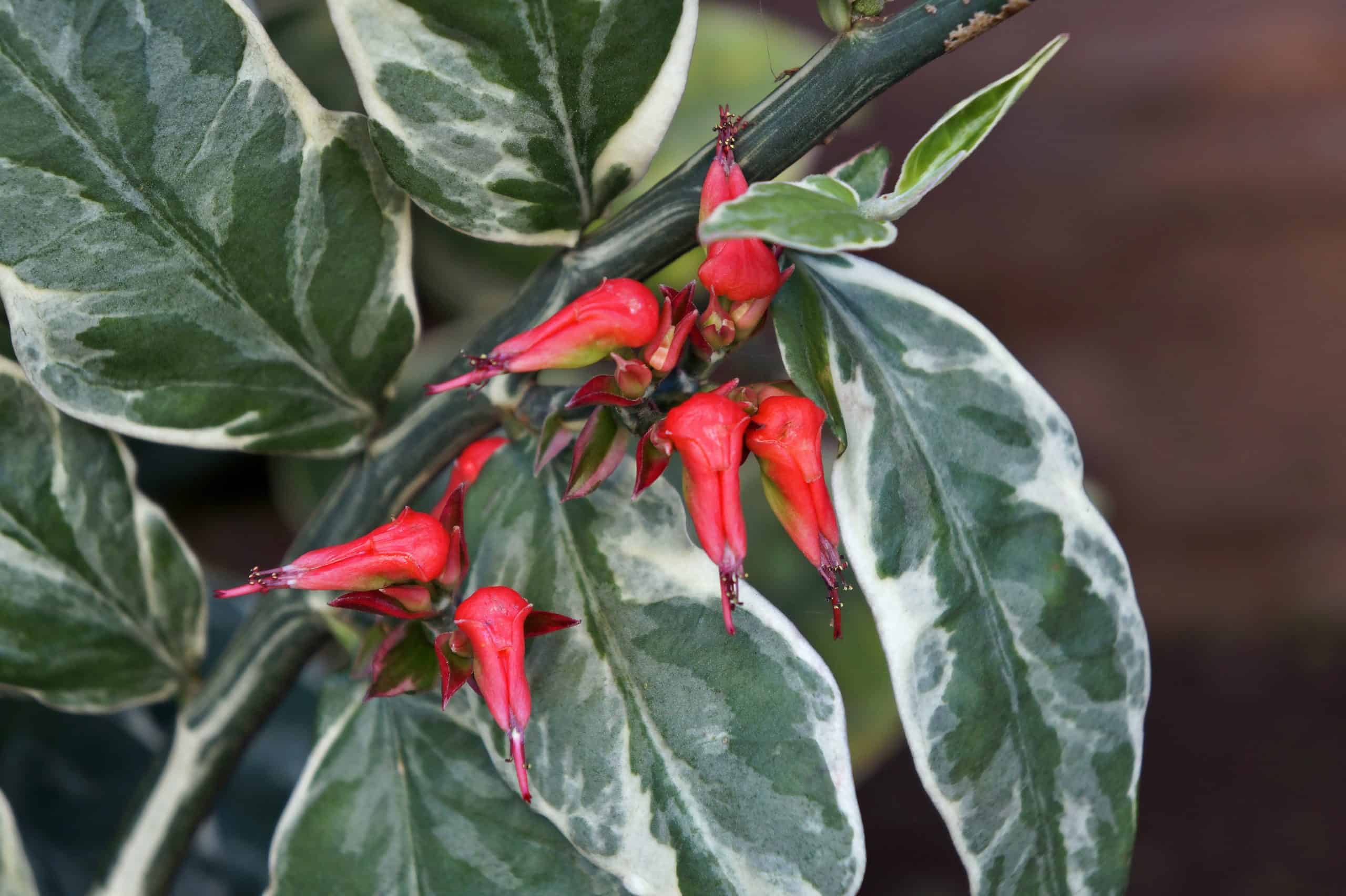
Buy it from:
The Devil’s Backbone goes by many other names as well, including Redbird Flower, Christmas Candle, Slipper Plant, and Zig Zag Plant. It’s a leafy succulent that can reach up to 8 feet tall at maturity.
Bright, indirect sun is best, but Devil’s Backbone is more than capable of surviving lower light conditions when grown indoors. Direct sun, especially during the heat of summer, may result in sunburned leaves.
Like other Euphorbia, Devil’s Backbone are best propagated with cuttings, but care must be taken to avoid the sap, which can cause skin irritation.
21. Flaming Katy, Kalanchoe blossfeldiana

Buy it from:
This bush-like succulent is known for its clusters of vibrant flowers, which come in a range of colors including purple, pink, red, orange, white, and yellow. It’s a relatively small shrubby succulent, measuring just 1.5 feet tall and about the same in width.
Flaming Katy prefers bright indirect light but will do well growing in shade. The full sun should be avoided as the leaves burn easily in direct sunlight.
If you want to add a splash of color to your indoor succulent collection, Flaming Katy and its brightly colored and long-lasting flowers would be a perfect addition.
What low light succulents have you had success with growing indoors in low light? Tell us below!




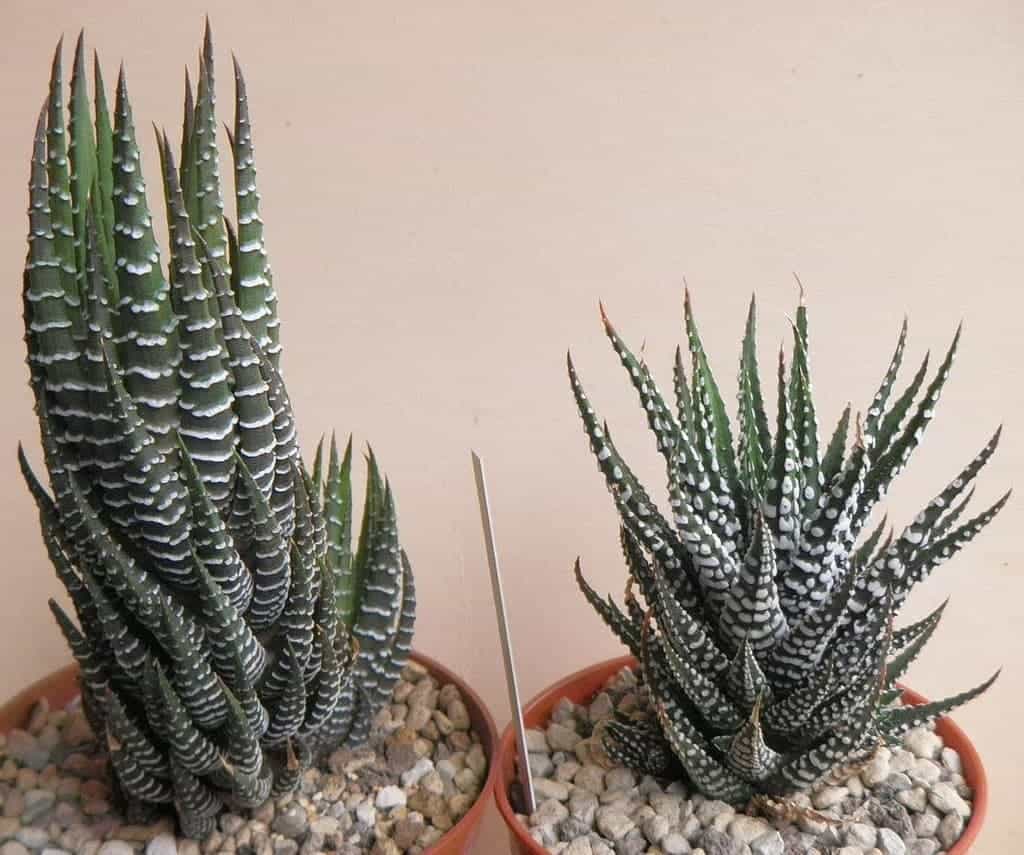

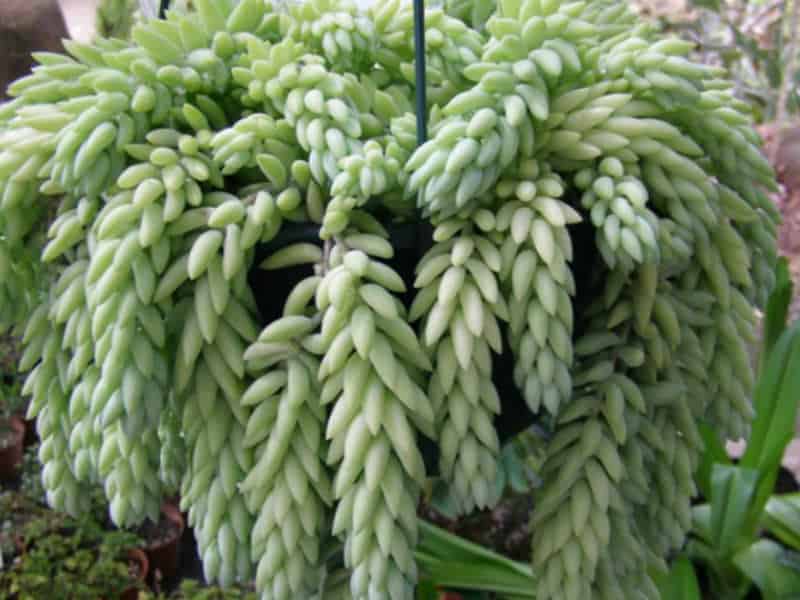
Marcia
I've read elsewhere that Sanseveria is toxic to pets. Are any of these safe for cats?
Patrick Grubbs
Good question - and you're right! Sansevierias are toxic. So are jade plants. The cotyledon, haworthia, palm, Schlumbergera, and aloe are all safe 🙂
Sabrina
Aloe are NOT safe for pets
Patrick Grubbs
You are correct!
thakor kirti
thnaks for sharing good information for us good
Patrick Grubbs
my pleasure!
Yolanda
I have 6 out of 10 already so I'm in good shape to make some low light arrangements. Thanks for the great info.
Angel B Johnston
Thank you. Please keep writing.
Del
I made a fairy garden with several succulents that a friend gave me. I used cactus soil. On top of the soil I added sheet moss to add to the realism of the design. Is sheet moss a bad thing to have with succulents?